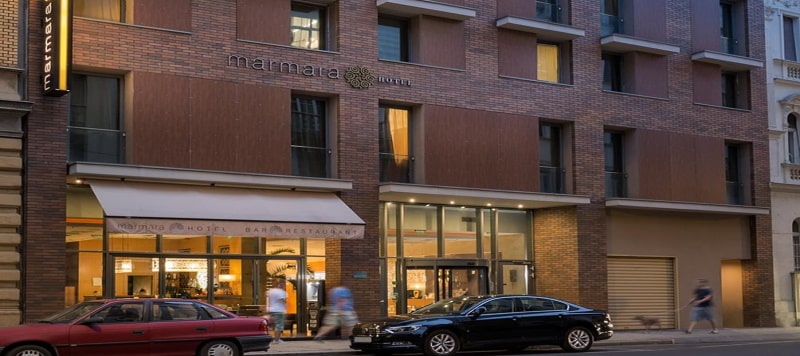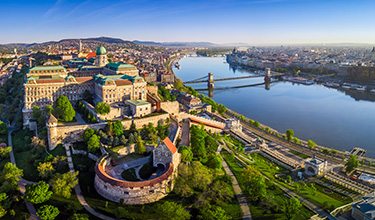
You can search for holidays
Hungary Holidays
Land-locked Hungary has become one of the most popular holiday destinations in Europe. Visitors love the friendly atmosphere of cities such as Budapest, the varied natural landscape of the country's ten national parks, and the lively nightlife of clubs and restaurants.The Great Plain of Hungary lies across the south and west, covering more than half the country. The extensive grasslands include lakes and marshes where migratory birds descend every autumn.
Hungary is noted for its mineral-rich spas and thermal baths. There are more than 1,300 scattered around the country with each one varying in its composition depending on the local minerals.
Visitors love to dine on traditional Hungarian cuisine such as beef and vegetable goulash that's heavily spiced with paprika. The most well-known ingredients in Hungarian desserts are marzipan and chocolate. They are so popular, they each have a museum dedicated to them in the centre of Budapest.
Map of Hungary

Marmara Hotel Budapest
Budapest, Nagy Ignác u. 21, 1055 Hungary
Top Destinations In Hungary

Budapest
Budapest, the capital of Hungary, was originally a Roman town established in the first century AD. By the Middle Ages, it had grown into Buda on one side of the River Danube and Pest on the other. In 1873, the two halves merged into Budapest. The variety of architecture, including Romanesque, Gothic and Renaissance, has constantly evolved, giving the city a distinctive character. Budapest is full of exciting contrasts. The cultural heritage and traditions sit comfortably with contemporary music, nightclubs and the laid-back atmosphere of ruins bars. Relaxing spas and adventurous outdoor activities make a visit to Budapest complete.
Helpful Information About Hungary
Currency: You’ll be spending Hungarian Forints.
Language: Hungarian
Local Time: Ahead by one hour BST, two hours GMT.
Flight time from the UK: Two hours, thirty minutes.
Tourist Information: Visit the official Hungarian tourist information site for lots of helpful information regarding upcoming events, where to go, what to do, and how to get around.
Health/Travel Restrictions:To travel to Hungary, British citizens need a valid passport. A visa is not required. For up to date travel advice and health recommendations visit the government’s travel advice for Hungary.
Other FAQs:
Q: Will Covid-19 affect my holiday to Hungary?
A: Currently no restrictions.
Q: When should you holiday in Hungary?
A: May or September when tourism's limited.
Q: Is there a dress code in Budapest's thermal baths?
A: Swimming costumes must be worn.
Q: Is Hungary expensive to visit?
A: It's regarded as inexpensive.
Top Things to Do in Hungary
Thirteenth-century Buda Castle includes additional Baroque embellishment. The interior charts the splendour of the nineteenth-century Austro-Hungarian Empire. Fisherman's Bastion, a fortified tower on Castle Hill, provides amazing views of the city. Saint Stephen's Basilica is an impressive neoclassical cathedral completed in 1905. It features symmetrical towers, a domed roof and relics of Hungary's first king.
Liberty Square has impressive architecture, green spaces and cosy cafes. It includes many historic monuments and statues. Budapest has many thermal baths including the atmospheric Rudas Turkish Baths that date from the seventeenth century. At weekends, Lukacs Thermal Bathe becomes a steamy party venue. Other entertainments include opera, theatres, nightclubs and outdoor events such as the Sziget Music Festival.
River cruises on the Danube are always popular for sightseeing. Many operate at night when local attractions are illuminated. There are also cruises for fishing enthusiasts. Paddleboarding and kayaking are some of the watersports on the Danube. Visit Margaret Island in the middle of the Danube for a wonderful day out. It has beautiful gardens and woodlands, a ruined monastery, mini zoo and adventure playgrounds. There's also a relaxing thermal spa and a tower built in 1911 that provides panoramic views of Budapest.
Weather in Hungary
The temperature during the summer is around 20°C (69°F) with heatwaves of up to 30°C (86°F) in July. The winter usually has an average temperature of -1°C (29°F). January is the coldest month when temperatures occasionally fall to -25°C (-14°F). There is often snowfall of at least 2" (5 cm). The wettest month of the year is May with an average of nine rainy days.
Looking for other holidays?
Copyright ©2025 Brightsun Travel. All rights reserved.

